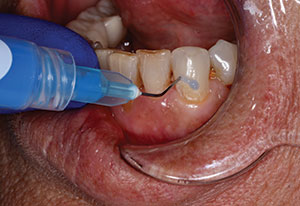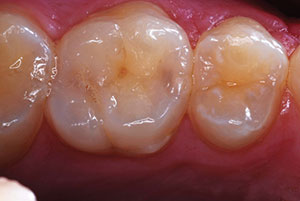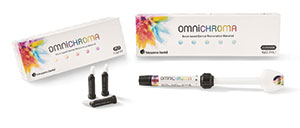INTRODUCTION
There are many developments in dental materials with each passing year, but one of the most established solutions for a broken or structurally compromised tooth is a crown. Dental crowns have been constructed utilizing composite, porcelain and gold (and semi- and nonprecious metals), several all-porcelain varieties, and recently zirconia. The shift in dentistry to lifelike restorations that mimic natural tooth structure is undeniable, and zirconia crowns are considered “cosmetic” in nature compared to certain other alternative crown materials. Based on perceived and actual patient demand owing to aesthetic and health concerns, material choices have dramatically shifted to “metal-free” wherever possible. This shift to “metal-free” is a bit ironic, since dental zirconia is technically an oxidized metal but is considered by dentists and patients to be metal-free.1
Initially, zirconia crowns were predominantly fabricated with a zirconia coping layered or pressed with different types of porcelain. Recently, a growing number of monolithic (full-contour) zirconia crowns have been requested by dentists, predominantly as a result of ubiquitous laboratory marketing. These full-contour zirconia crowns are extraordinarily strong, and it has been argued that they are just as aesthetic as layered zirconia crowns.2,3 In a routine restorative case, several varieties of zirconia crowns were fabricated for comparison, and the results of this clinical case report follow.
CASE REPORT
Diagnosis and Treatment Planning
A 69-year-old male presented with failing gold onlay restorations on teeth Nos. 29 and 30. After several decades of service, the patient was having occasional symptoms when drinking cold beverages, and a contact had opened between the 2 teeth (Figure 1). In addition, the margins were slightly open in several areas around both gold restorations, and caries were suspected. Finally, the patient desired restorations that were more aesthetic in this region of the mouth.
There are multiple aesthetic materials that would be indicated for this region, including lithium disilicate, leucite-reinforced porcelain, and zirconia-based restorations. A discussion with the patient in this particular case confirmed that both teeth would be crowned with a zirconia-based restoration. Ease of cementation of the zirconia-based restoration with a resin-modified glass ionomer cement contributed to the decision, as the mesial margin of tooth No. 30 would clearly be subgingival based on preoperative radiographs.4
Clinical Treatment
The patient was anesthetized with one carpule of Septocaine (Septodont), and the teeth were isolated (Isolite [Isolite Systems]). The old restorations were removed using a raptor 557 bur (Axis Dental) and a high-speed electric handpiece (KaVo Dental Handpieces) (Figures 2 and 3). The remaining cements, liners, and caries were removed with a series of diamond burs, ie, KS0, KS1SC, KS3SC, and KS5SC (KOMET USA) and the rough crown margins were initially prepared (Figures 4 and 5).
After all visible caries were removed (Figure 6), the remaining dark areas were verified to be sound, and an antimicrobial scrub (Consepsis Pumice Scrub [Ultradent Products]) was applied to the preparations and brushed across the teeth with a Star Brush (Ultradent Products) inside a slow-speed latch handpiece (KaVo Dental Handpieces). A size 1 retraction cord (GingiBRAID [DUX Dental]) was carefully placed in the sulcus of both teeth to avoid fluid contamination during the crown buildups and to minimize bleeding potential in any subgingival preparation areas.
 |
 |
| Figure 1. Preoperative view of lower arch, including failing restorations on teeth Nos. 29 and 30. | Figure 2. Working view of the lower arch teeth after restoration removal. |
 |
 |
| Figure 3. Close-up view of teeth Nos. 29 and 30, demonstrating decay and leaking restorations. | Figure 4. Lower arch view after initial cleanup. |
 |
 |
| Figure 5. Close-up view of teeth Nos. 29 and 30, after caries removal and initial margin placement. | Figure 6. Lower arch view of the completed preparations. |
Once cleaned and ready for the crown buildups, the teeth were etched with 37% phosphoric acid (Ultra-Etch [Ultradent Products]) for 20 seconds per tooth and thoroughly rinsed. A desensitizer (Telio Desensitizer [Ivoclar Vivadent]) was placed for 20 seconds per tooth, and the excess liquid was evaporated with a high-speed evaporation tip. A fifth-generation adhesive (One-Step [BISCO Dental Products]) was applied for a period of more than 20 seconds per tooth, and the excess solvent was removed again, with the aid of high-speed evaporation. This evaporation technique effectively removes the undesirable solvent (acetone), without blowing uncured liquid resin monomer across the adjacent teeth and into the sulcus, potentially causing bleeding.5 Another benefit is a cleaner margin when the preparation is completed, as there is limited concern for unintentional contamination of the sulcular area that could have arisen from “blowing” the monomer with an air syringe to remove the solvent.6 The teeth were each light-cured for 20 seconds with an LED light (Bluephase [Ivoclar Vivadent]), and the build-up material was applied (Luxacore [Zenith Dental]) and light-cured for 20 seconds per tooth.
Next, the preparations were completed, and the final margin positions were established and smoothed with the KS3SC, KS5SC, KS6SC, and 8856.021 burs (KOMET USA). Careful consideration was made to ensure accurate and smooth margins with minimal disruption to the surrounding tissue; even on the mesial of tooth No. 30 where the previous restoration’s margin was slightly subgingival (Figures 7 and 8).
Final impressions were made utilizing vinyl polysiloxane impression material (Imprint 3 Garant [3M ESPE]). Then, the provisional restorations were formed (Protemp [3M ESPE]) and seated with provisional cement (Fynal [DENTSPLY Caulk]). The patient was given postoperative and hygiene instructions for care of the provisionals during the following 3 weeks. Instructions were sent to the dental laboratory team requesting the fabricating of 4 different types of zirconia crowns:
- Full-contour zirconia: polished only (FCZP) (Figure 9)
- Full-contour zirconia: stained and glazed (FCZSG) (Figure 10)
- Layered porcelain (2 layers) during a zirconia coping (LPZ) (Figure 11)
- Multilayered porcelain (5 layers) over a zirconia coping (MLPZ) (Figure 12).
 |
 |
| Figure 7. Close-up view of teeth Nos. 29 and 30, after crown buildups and preparation completion. | Figure 8. Lateral view of the completed preparations. |
 |
 |
| Figure 9. Laboratory lateral view of the polished full-contour zirconia restorations. | Figure 10. Laboratory lateral view of the full-contour of the stain and glazed full-contour zirconia restorations. |
 |
 |
| Figure 11. Laboratory lateral view of the layered zirconia restorations. | Figure 12. Laboratory lateral view of the multiple-layered zirconia restorations. |
It was requested that the 4 crown types were to be made as identical as possible in shape and contour for comparison purposes at the delivery appointment.
Observations at Placement
As this was an experiment for the purpose of comparing the aesthetics of different zirconia crown types, each crown was photographed in the patient’s mouth. The crowns will be discussed in 2 categories: full-contour and layered.
In the case of the full-contour restorations, the FCZP pair appeared to have a high luster, and the physical zirconia material simply looked different in every way than a natural tooth (Figures 13 and 14). Zirconia is opaque by nature,7,8 and the more translucent a restoration is (given a healthy preparation stump shade), the more natural the restoration will appear.9,10 As there is no ability to “block out” the opaque zirconia coping with layering, the polished-only crowns’ opacity stood out significantly among the surrounding natural dentition.
 |
 |
| Figure 13. Lateral view of the polished full-contour zirconia restorations. | Figure 14. Occlusal view of the full-contour zirconia polished restorations. |
 |
 |
| Figure 15. Lateral view of the stain and glazed full-contour zirconia restorations. | Figure 16. Occlusal view of the full-contour zirconia stained and glazed restorations. |
The FCZSG pair clearly appeared more aesthetic than the FCZP crowns (Figures 15 and 16). From the author’s experience, in restorative situations when there is a dark preparation stump, zirconia restorations are often considered or selected as the coping material. This selection is based on zirconia’s ability to block the dark underlying stump from show-through in the restoration.7,11 However, if the entire crown is comprised of this opacious material, the limited light transmission through this thickness of restorative material appears to have a substantial aesthetic downside. In fact, while the FCZSG crowns offered slight aesthetic improvement, it is very difficult to consistently stain and glaze an all-zirconia crown.12
It was subjectively determined that the 2 varieties of layered crown pairs were aesthetically superior. Not only did the layered restorations more closely mimic the natural shade and translucency characteristics of the surrounding natural dentition; they looked far more realistic to the patient himself. When layering the porcelain, a zirconia coping is designed to fit to the restoration margin, much like a metal coping would be designed prior to layering porcelain over a PFM crown.13,14 Although the zirconia coping is opaque, the porcelain layered over it can be much more translucent. The combination of coping and layered porcelain can produce very aesthetic results while still achieving an extremely accurate marginal fit of the crown without adding substantial fabrication time.15,16
 |
 |
| Figure 17. Lateral view of the layered zirconia restorations. | Figure 18. Occlusal view of the layered zirconia restorations. |
 |
 |
| Figure 19. Lateral view of the multiple-layered zirconia restorations. | Figure 20. Occlusal view of the multiple layered zirconia restorations. |
There was a slight increase in aesthetics with the MLPZ pair versus the LPZ pair (Figures 17 to 20), and this was selected as the crown pair to cement into place after discussion with the patient.
DISCUSSION
The layering technique requires more time and, therefore, typically higher dental laboratory fees for the final restoration. In general, the strength of layered porcelain to substrates (copings) is in the 120 MPa range;2 this applies to PFM crowns as well as layered zirconia restorations. This means a decrease in strength from more than 1,000 MPa (the full-contour zirconia restoration), but clearly a more aesthetic restoration for the patient.12 It has been proven that the coping design for layered zirconia crowns has the largest impact on resistance to chipping of layered porcelain off of these restorations.10,17-19 If the dental laboratory team is able to meet the known ideals in coping design, a strength of layered porcelain in the 120 MPa range should be successful, as it has been utilized for decades with PFM restorations.
A potential drawback of full-contour zirconia based restorations could be wear compatibility to the opposing enamel, reminiscent of Vita Alpha porcelain, during routine function. Wear to teeth opposing zirconia has not been studied with significance.20,21 Furthermore, in a clenching or bruxing patient, what is the impact of full-contour zirconia on the opposing dentition long-term?
Unfortunately, no dental restoration can be expected to last forever. Therefore, inevitably many of these crowns will need to be replaced. When the time comes, can a full-contour zirconia crown be easily removed? Will the heat and vibration generated in the removal of a full-contour zirconia crown likely damage instruments and, more importantly, the patient’s underlying tooth?
If the pros and cons of layered versus full-contour zirconia crowns are compared, the less aesthetic full-contour zirconia restorations, as subjectively determined in this case study, also have the least long-term research on wear to the opposing dentition, and would be the most difficult and potentially damaging to remove in the future.
It appears that the increasing trend toward full-contour zirconia-based crowns should be met with caution, and not only due to aesthetic limitations. Practices placing these full-contour restorations must be equipped with staining, glazing, and polishing equipment for use before seating these crowns. Other factors need to be considered, including occlusal adjustments that would require the placement of the opposing tooth against a “nonpolished” zirconia crown that will potentially wear faster.
CONCLUSION
Today, dentists and patients demand predictable materials, treatments, and results. However, the lack of in vivo studies makes it difficult to draw any effective conclusions regarding full-contour zirconia-based crowns, rendering the growing use of these crowns for our patients premature.
Acknowledgement
The author extends a special thanks to Todd Franson of First Impressions Dental Lab in Schaumburg, Ill, for his outstanding laboratory work, and for his willingness to make the extra restorations required for the purpose of material and technique comparisons.
References
- Giordano R, McLaren EA. Ceramics Overview: classification by microstructure and processing methods. Compend Contin Educ Dent. 2010;31:682-688.
- Guazzato M, Proos K, Quach L, et al. Strength, reliability and mode of fracture of bilayered porcelain/zirconia (Y-TZP) dental ceramics. Biomaterials. 2004;25:5045-5052.
- Vichi A, Louca C, Corciolani G, et al. Color related to ceramic and zirconia restorations: a review. Dent Mater. 2011;27:97-108.
- Komine F, Blatz MB, Matsumura H. Current status of zirconia-based fixed restorations. J Oral Sci. 2010;52:531-539.
- van Dijken JW, Sjöström S. Development of gingivitis around aged restorations of resin-modified glass ionomer cement, polyacid-modified resin composite (compomer) and resin composite. Clin Oral Investig. 1998;2:180-183.
- Magne P, Nielsen B. Interactions between impression materials and immediate dentin sealing. J Prosthet Dent. 2009;102:298-305.
- Raptis NV, Michalakis KX, Hirayama H. Optical behavior of current ceramic systems. Int J Periodontics Restorative Dent. 2006;26:31-41.
- Heffernan MJ, Aquilino SA, Diaz-Arnold AM, et al. Relative translucency of six all-ceramic systems. Part 1: core materials. J Prosthet Dent. 2002;88:4-9.
- Luo XP, Zhang L. Effect of veneering techniques on color and translucency of Y-TZP. J Prosthodont. 2010;19:465-470.
- McLaren EA, Giordano RA II. Zirconia-based ceramics: material properties, esthetics, and layering techniques of a new veneering porcelain, VM9. Quintessence Dent Technol. 2005;28:99-111.
- Barão VA, Gennari-Filho H, Goiato MC, et al. Factors to achieve aesthetics in all-ceramic restorations. J Craniofac Surg. 2010;21:2007-2012.
- Yener ES, Ozcan M, Kazazoğlu E. The effect of glazing on the biaxial flexural strength of different zirconia core materials. Acta Odontol Latinoam. 2011;24:133-140.
- Edelhoff D, Brix O. All-ceramic restorations in different indications: a case series. J Am Dent Assoc. 2011;142(suppl 2):14S-19S.
- Guazzato M, Proos K, Sara G, et al. Strength, reliability, and mode of fracture of bilayered porcelain/core ceramics. Int J Prosthodont. 2004;17:142-149.
- Martínez-Rus F, Suárez MJ, Rivera B, et al. Evaluation of the absolute marginal discrepancy of zirconia-based ceramic copings. J Prosthet Dent. 2011;105:108-114.
- Guess PC, Schultheis S, Bonfante EA, et al. All-ceramic systems: laboratory and clinical performance. Dent Clin North Am. 2011;55:333-352, ix.
- Larsson C. Zirconium dioxide based dental restorations. Studies on clinical performance and fracture behaviour. Swed Dent J Suppl. 2011;(213):9-84.
- McLaren EA, White SN. Survival of In-Ceram crowns in a private practice: a prospective clinical trial. J Prosthet Dent. 2000;83:216-222.
- McLaren EA, Whiteman YY. Ceramics: rationale for material selection. Compend Contin Educ Dent. 2010;31:666-672.
- Ghuman T, Beck P, Ramp LC, et al. Wear of enamel antagonist to ceramic surfaces. J Dent Res. 2010;89(special issue B). Abstract 1394.
- Jung YS, Lee JW, Choi YJ, et al. A study on the in-vitro wear of the natural tooth structure by opposing zirconia or dental porcelain. J Adv Prosthodont. 2010;2:111-115.
Dr. Engelberg earned his BS degree in psychology at Indiana University in 1999 and his DDS from the Indiana University School of Dentistry in 2003. His private practice, Arlington Heights Smiles, focuses on primarily adult cosmetic and restorative dentistry. Dr. Engelberg lectures on aesthetic dentistry and has published articles on cosmetic dentistry, full-mouth rehabilitation, and porcelain veneers. Dr. Engelberg is also a co-director of “Total Advantage Live,” a hands-on course teaching cosmetic dentistry and veneers with ceramist Brad Jones to other dentists. Visit ahsmiles.com or totaladvantagelive.com for specific information on cosmetic cases, dental treatment, or upcoming course details. He can be reached at (847) 259-6988 or via e-mail at baengelb@hotmail.com.
Disclosure: Dr. Engelberg reports no disclosures.











